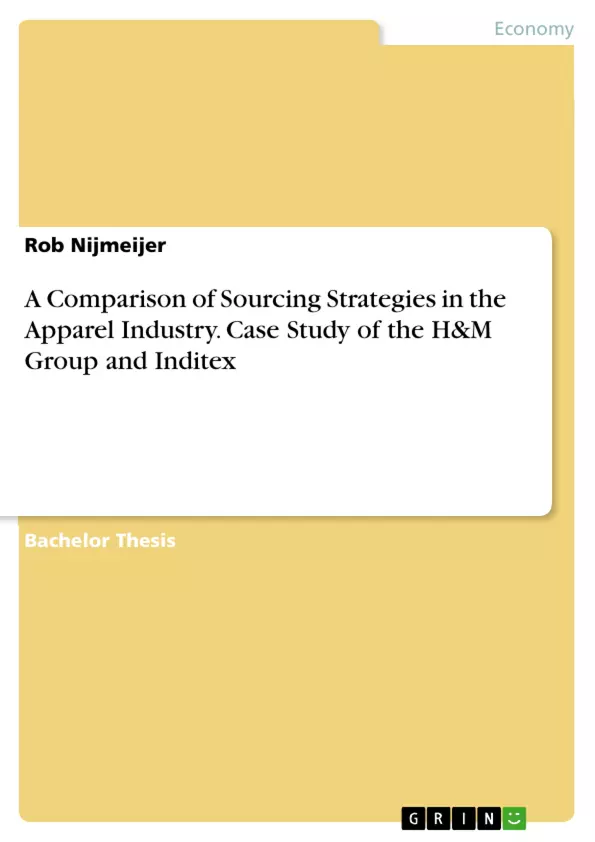In this thesis a comparison is made between the H&M Group and Inditex to measure the differences in overall performance of outsourcing and in-house production in the apparel industry. Outsourcing is often discussed in the literature as the perfect solution to cost reductions however the literature lacks results on the actual performance; this article measures the performance obtained through outsourcing and in-house production. H&M is studied because it has a fully outsourced production, where Inditex mostly produces its products in-house. Performance is measured by the follow variables: costs, agility, asset utilization and product quality. Costs and asset utilization were measured using an independent samples t-test; comparing costs of goods sold salary expenses and overall expenses as a percentage of the revenue, asset utilization is measured by comparing the return on assets ratio. Agility is studied by an in-depth analysis and product quality based on a survey on consumer perception.
The results show that H&M has significantly reduced its costs by outsourcing, while Inditex with higher costs is able to keep a very short lead-time. H&M has been successful in increasing return on assets and product quality is perceived equal for both companies. This article contributes to the field of research by showing that outsourcing does lead to cost reduction, however in-house production leads to better performance in agility.
Table of Contents
- Introduction
- 1.1 Motivation
- 1.2 Definitions & Problem statement
- 1.3 Preview of the paper
- 2. Background
- 2.1 Fast fashion market
- 2.2 Inditex
- 2.3 H&M
- 2.4 Model: Measure sourcing performance
- 3. Methodology
- 3.1 Data collection
- 3.2 Unit of analysis
- 3.3 Methodology
- 3.4 Validity
- 3.5 Reliability
- 4. Analysis and Results
- 4.1 Costs of goods sold
- 4.2 Salary expenses
- 4.3 Overall expenses
- 4.4 Findings
- 5. Quality
- 6. Lead-time
- 7. Asset utilization
- 8 Conclusion
- 8.1 Limitations
- 8.2 Future recommendations
Objectives and Key Themes
This article aims to compare the overall performance of outsourcing and in-house production in the apparel industry by analyzing the H&M Group and Inditex. It investigates the impact of outsourcing on cost reduction, agility, asset utilization, and product quality.
- The effectiveness of outsourcing versus in-house production in the apparel industry.
- The impact of outsourcing on cost reduction and asset utilization.
- The influence of in-house production on agility and lead-time.
- The role of vertical integration and disintegration in supply chain management.
- The perception of product quality in outsourced versus in-house produced products.
Chapter Summaries
The introduction provides the motivation and background of the study, highlighting the increasing trend of outsourcing in the apparel industry and the need to assess its actual performance. It defines key terms, introduces the companies being compared – H&M and Inditex – and sets the research question.
The background chapter delves into the fast fashion market, providing context for the study. It then describes the business models and sourcing strategies of both H&M and Inditex, highlighting their contrasting approaches to production.
The methodology chapter explains the data collection, unit of analysis, and methods employed to measure costs, quality, service, agility, and asset utilization. The validity and reliability of the research are also addressed.
The analysis and results chapter presents the findings regarding the performance of outsourcing based on the measured variables: cost of goods sold, salary expenses, overall expenses, and return on assets.
Keywords
The article focuses on the key themes of outsourcing, in-house production, supply chain management, fast fashion, vertical integration, vertical disintegration, cost reduction, agility, asset utilization, product quality, H&M, and Inditex. The research utilizes quantitative and qualitative data analysis to compare the performance of outsourcing and in-house production in the apparel industry.
- Quote paper
- Rob Nijmeijer (Author), 2015, A Comparison of Sourcing Strategies in the Apparel Industry. Case Study of the H&M Group and Inditex, Munich, GRIN Verlag, https://www.grin.com/document/310193



